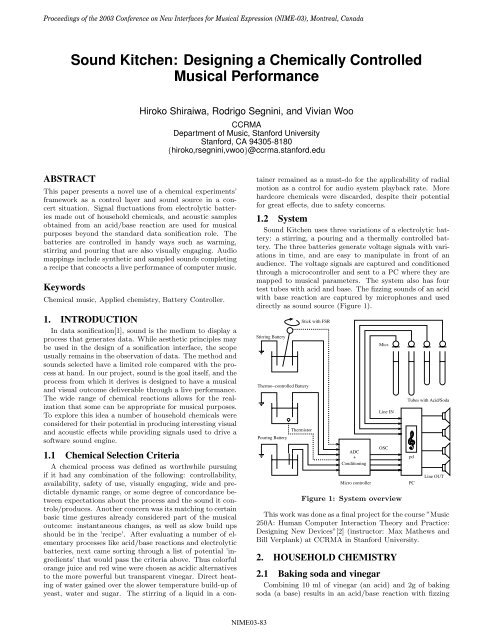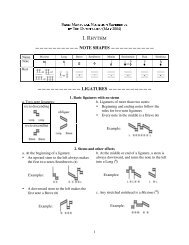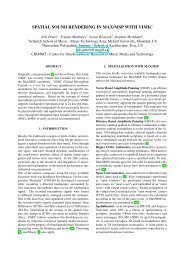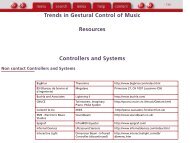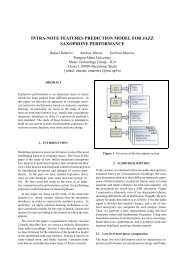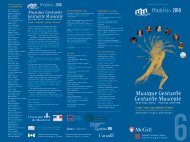Sound Kitchen: Designing a Chemically Controlled Musical - CiteSeer
Sound Kitchen: Designing a Chemically Controlled Musical - CiteSeer
Sound Kitchen: Designing a Chemically Controlled Musical - CiteSeer
Create successful ePaper yourself
Turn your PDF publications into a flip-book with our unique Google optimized e-Paper software.
Proceedings of the 2003 Conference on New Interfaces for <strong>Musical</strong> Expression (NIME-03), Montreal, Canada<br />
ABSTRACT<br />
<strong>Sound</strong> <strong>Kitchen</strong>: <strong>Designing</strong> a <strong>Chemically</strong> <strong>Controlled</strong><br />
<strong>Musical</strong> Performance<br />
Hiroko Shiraiwa, Rodrigo Segnini, and Vivian Woo<br />
This paper presents a novel use of a chemical experiments’<br />
framework as a control layer and sound source in a concert<br />
situation. Signal fluctuations from electrolytic batteries<br />
made out of household chemicals, and acoustic samples<br />
obtained from an acid/base reaction are used for musical<br />
purposes beyond the standard data sonification role. The<br />
batteries are controlled in handy ways such as warming,<br />
stirring and pouring that are also visually engaging. Audio<br />
mappings include synthetic and sampled sounds completing<br />
arecipethatconcocts a live performance of computer music.<br />
Keywords<br />
Chemical music, Applied chemistry, Battery Controller.<br />
1. INTRODUCTION<br />
In data sonification[1], sound is the medium to display a<br />
process that generates data. While aesthetic principles may<br />
be used in the designofasonification interface, the scope<br />
usually remains in the observation of data. The method and<br />
sounds selected have a limited role compared with the process<br />
at hand. In our project, sound is the goal itself, and the<br />
process from which it derives is designed to have a musical<br />
and visual outcome deliverable through a live performance.<br />
The wide range of chemical reactions allows for the realization<br />
that some can be appropriate for musical purposes.<br />
To explore this idea a number of household chemicals were<br />
considered for their potential in producing interesting visual<br />
and acoustic effects while providing signals used to drive a<br />
software sound engine.<br />
1.1 Chemical Selection Criteria<br />
Achemicalprocess was defined as worthwhile pursuing<br />
if it had any combination of the following: controllability,<br />
availability, safety of use, visually engaging, wide and predictable<br />
dynamic range, or some degree of concordance between<br />
expectations about the process and the sound it controls/produces.<br />
Another concern was its matching to certain<br />
basic time gestures already considered part of the musical<br />
outcome: instantaneous changes, as well as slow build ups<br />
should be in the ’recipe’. After evaluating a number of elementary<br />
processes like acid/base reactions and electrolytic<br />
batteries, next came sorting through a list of potential ’ingredients’<br />
that would pass the criteria above. Thus colorful<br />
orange juice and red wine were chosen as acidic alternatives<br />
to the more powerful but transparent vinegar. Direct heating<br />
of water gained over the slower temperature build-up of<br />
yeast, water and sugar. The stirring of a liquid in a con-<br />
CCRMA<br />
Department of Music, Stanford University<br />
Stanford, CA 94305-8180<br />
{hiroko,rsegnini,vwoo}@ccrma.stanford.edu<br />
NIME03-83<br />
tainer remained as a must-do for the applicability of radial<br />
motion as a control for audio system playback rate. More<br />
hardcore chemicals were discarded, despite their potential<br />
for great effects, due to safety concerns.<br />
1.2 System<br />
<strong>Sound</strong> <strong>Kitchen</strong> uses three variations of a electrolytic battery:<br />
a stirring, a pouring and athermally controlled battery.<br />
The three batteries generate voltage signals with variations<br />
in time, and are easy to manipulate in front of an<br />
audience. The voltage signals are captured and conditioned<br />
through a microcontroller and sent to a PC where they are<br />
mapped to musical parameters. The system also has four<br />
test tubes with acid and base. The fizzing sounds of an acid<br />
with base reaction are captured by microphones and used<br />
directly as sound source (Figure 1).<br />
Stirring Battery<br />
Thermo−controlled Battery<br />
Pouring Battery<br />
Thermistor<br />
Stick with FSR<br />
ADC<br />
+<br />
Conditioning<br />
Micro controller<br />
Mics<br />
Line IN<br />
OSC<br />
Figure 1: System overview<br />
Tubes with Acid/Soda<br />
pd<br />
PC<br />
Line OUT<br />
This work was done as a final project for the course ”Music<br />
250A: Human Computer Interaction Theory and Practice:<br />
<strong>Designing</strong> New Devices”[2] (instructor: Max Mathews and<br />
Bill Verplank) at CCRMA in Stanford University.<br />
2. HOUSEHOLD CHEMISTRY<br />
2.1 Baking soda and vinegar<br />
Combining 10 ml of vinegar (an acid) and 2g of baking<br />
soda (a base) results in an acid/base reaction with fizzing
Proceedings of the 2003 Conference on New Interfaces for <strong>Musical</strong> Expression (NIME-03), Montreal, Canada<br />
sounds inside a test tube. The products of all acid/base<br />
reactions are a salt, water, and carbon dioxide gas:<br />
Acid + Base −→ salt + water + carbon dioxide gas<br />
The specific reaction in this system is:<br />
CH3COOH + NaHCO3 −→ NaC2H3O2 + H2CO3<br />
where CH3COOH is acetic acid, NaHCO3 is baking soda<br />
and NaC2H3O2 is sodium acetate. This is followed by<br />
H2CO3 −→ H2O + CO2<br />
where CO2 is a gas, dispersed as bubbles into the atmosphere.<br />
This part of the reaction causes a fizzing sound<br />
which is captured by microphones and processed as an acoustic<br />
signal.<br />
2.2 Electrolytes in Batteries<br />
Avoltage can be created when two polarized electrodes,<br />
e.g. copper and aluminum strips, are inserted in an electrolytic<br />
substance. The negative ions in the electrolyte are<br />
attracted to the aluminum strip, while positively charged<br />
ones are attracted to the copper strip. Temperature increase/decrease<br />
and electrolyte volume are used to control<br />
the total charge of the system.<br />
Citric Acid<br />
Citric acid, a prominent component of orange juice is represented<br />
by the chemical formula C6H8O7 · H2O. When the<br />
copper and aluminum (the electrodes) are submerged in the<br />
orange juice (the electrolyte), the hydronium ions (H3O + )<br />
of the orange juiceareattracted to the copper electrode and<br />
the C6H7O −<br />
7 ions are attracted to the aluminum electrode<br />
(Figure 2). 40 ml of orange juice are used to charge the<br />
stirring battery.<br />
Red Wine<br />
Red wine may contain three acid derivatives: benzoic acid<br />
derivatives, cinnamic acid derivatives, or flavonoid derivatives<br />
(Figure 3). This substance works much like that of<br />
orange juice except that the C6H7O −<br />
7 is replaced by one of<br />
the acid derivatives of the wine. 400 ml of water and 100 ml<br />
of red wine are used to charge the pouring battery.<br />
Temperature control<br />
In this system protons (H + )andhydroxide ions (OH − )are<br />
the attaching elements. After heating around 60 degrees<br />
Celsius, the electrolytic properties of water become more<br />
intense, therefore more interesting as a slow paced control<br />
signal. Heat increases the agitation of the ions in the electrolyte<br />
thereby increasing the flow of the electrons (Figure<br />
4). Our thermo-controlled battery uses a tea pot coil warmer<br />
to heat 250 ml of water.<br />
HO<br />
OH<br />
OH<br />
O<br />
O<br />
+<br />
OH<br />
O<br />
O<br />
H<br />
H<br />
HO<br />
OH<br />
OH<br />
O<br />
O<br />
O<br />
O<br />
+ H O<br />
Figure 2: Citric acid gives up one hydrogen ion to a<br />
water molecule resulting in negatively and positively<br />
charged molecules<br />
−<br />
H<br />
H<br />
+<br />
NIME03-84<br />
HO<br />
R1<br />
Cinnamic Acid Derivatives<br />
(where R1 and R2 are acids)<br />
HO<br />
R2<br />
OH<br />
O<br />
COOH<br />
R1<br />
Benzoic Acid Derivatives<br />
(where R1 and R2 are acids)<br />
R2 CH CH COOH<br />
OH<br />
R1<br />
OH<br />
R2 Flavonoid Derivatives<br />
(where R1 and R2 are acids)<br />
Figure 3: Three acid derivatives that occur in<br />
red wines - benzoic acid derivatives, cinnamic acid<br />
derivatives, and flavonoid derivatives<br />
Al +<br />
e −<br />
−<br />
OH<br />
H O<br />
2<br />
H +<br />
e −<br />
Cu<br />
−<br />
Vout<br />
Figure 4: The water battery system where water is<br />
the electrolyte and a copper strip and an aluminum<br />
strip act as electrodes<br />
3. ENGINEERING<br />
An ATMega163 controller[3] is used to capture, condition<br />
and transmit signals from sensors in the chemical framework.<br />
AVRGCC is used for coding. Out of six input signals<br />
to theATMega163, four output signals are sent to a PC after<br />
conditioning via the serial port using Open <strong>Sound</strong> Control<br />
(OSC) [4].<br />
3.1 Tubes and Microphones<br />
Four small microphones are used to capture the sounds<br />
of the reaction of acid and soda in the test tubes. Signals<br />
are sent directly to four loud speakers via a spatialization<br />
patch in Pd [5], e.g. the first tube to the front right speaker,<br />
the second to the front left, the third to the rear right, the<br />
fourth to the rear left. Before performance, the portion of<br />
vinegar and soda is carefully chosen not to damage the microphones<br />
with foamy acidic bubbles. The soldered parts of<br />
microphones are coated with hot glue, to prevent rust.<br />
3.2 Batteries<br />
Stirring Battery<br />
The Stirring Battery exhibits a chaotic voltage flow when<br />
the electrolyte is stirred with a circular motion. For musical<br />
reasons, this is turned on and off in a controlled way.<br />
An FSR (Force Sensitive Resistor) attached to the stirring<br />
stick implements this switching functionality: raw voltage<br />
signal when the stick is held, or zeros when not held (Figure<br />
5). Both signals from the FSR and the battery are sent to
Proceedings of the 2003 Conference on New Interfaces for <strong>Musical</strong> Expression (NIME-03), Montreal, Canada<br />
the micro-controller where the flow control switching takes<br />
place.<br />
postprocessed signal<br />
250<br />
200<br />
150<br />
100<br />
50<br />
output from the stirring battery<br />
0<br />
0 10 20 30 40 50 60 70 80 90 100<br />
time (sec)<br />
Figure 5: Example output from the Stirring Battery<br />
showing voluntary on and off switching at four<br />
instances. Note that fast transients occur during<br />
stirring.<br />
Pouring Battery<br />
The Pouring Battery has two stages duringtheperformance:<br />
initially it is filled with plain water; then as some red wine<br />
is added, more ions charge the liquid, increasing the voltage<br />
output from the battery. By pouring the liquid into a different<br />
container, and back into tothebattery container this<br />
voltage fluctuates (Figure 6). Twocopperstrips are set in<br />
the battery with different but coherent signal outputs. One<br />
of them is sent to a Non-Inverting amplifier, made with an<br />
Op-amp, as to provide more dynamic range to the signal.<br />
voltage (V)<br />
1.5<br />
1.45<br />
1.4<br />
1.35<br />
1.3<br />
1.25<br />
output from the pouring battery<br />
Charge battery<br />
Pouring out<br />
1.2<br />
0 5 10 15 20 25 30 35 40<br />
time (sec)<br />
Pouring back<br />
Figure 6: Example output from the pouring battery<br />
showing voltage fluctuations as wine is added<br />
and the electrolyte is poured in/out the battery container<br />
Thermo-<strong>Controlled</strong> Battery<br />
The Thermo-controlled Battery generates a voltage vT which<br />
increases roughly proportional to the water temperature T<br />
within the approximate range of 60 < T < 100 degrees<br />
Celsius. During the performance a coil heater, cold water<br />
and ice are used to control temperatures. A thermistor is<br />
NIME03-85<br />
also used to set a temperature threshold around the boiling<br />
point. Both signals from the thermistor and the battery vT<br />
are sent to the micro-controller where the flow control takes<br />
place (Figure 7).<br />
voltage (V)<br />
postprocessed signal<br />
1<br />
0.95<br />
0.9<br />
0.85<br />
output from the thermo−controlled battery<br />
0.8<br />
After boiling<br />
0.75<br />
Remove heater<br />
Add cold water and ice<br />
0.7<br />
0 1 2 3 4 5 6 7 8<br />
200<br />
190<br />
180<br />
170<br />
160<br />
150<br />
Apply heater<br />
Output voltage is modified<br />
for musical expression<br />
time (min)<br />
0 1 2 3 4 5 6 7 8<br />
time (min)<br />
Figure 7: Signal from the thermo-controlled battery<br />
showing slow time transient during 8 minutes. Top :<br />
raw voltage output, Bottom : postprocessed signal<br />
4. MUSIC AND PERFORMANCE ASPECTS<br />
The metaphor used when composing music for this project<br />
was that of cooking. When preparing a dish, adding separate<br />
ingredients following a recipe results in a whole that is more<br />
than the sum of its parts. In our framework every chemical<br />
reaction contributes to the music as ’composed’ on a score<br />
designed for live performance.<br />
Since this composition is to be performed live, Pd was<br />
chosen as the sound engine where the incoming signals are<br />
translated into music.<br />
4.1 Signal Mapping<br />
Overall 4 input signals (signals 1 - 4) arrive into the Pd<br />
patch via the serial port using OSC. Additionally, 4 microphone<br />
signals (acoustic signals 1 - 4) are fed via the audio<br />
card and entered into Pd using 4 channels in the adc˜ object<br />
(analog-to-digital converter). The output of the whole<br />
patch is sent out through the audio card using 4 channels in<br />
the dac˜ object (digital-to-analog converter).<br />
Signal 1: Multi-rate Sampler<br />
Signal 1 is derived from the Stirring Battery and used to control<br />
the playback sample rate of two speech samples. While<br />
the stick is held, signals pass through, otherwise the input is<br />
shut down. When a signal is present, the Pd patch responds<br />
by fading in the voice samples, and depending on the motion<br />
achieved inside the container, the sample rate for playback<br />
varies. Based on tested behavior of this battery, whenever<br />
acriticalmotionspeed is achieved inside the container, the<br />
signal value raises, otherwise it settles and decays. Because<br />
of the non-linearity of the chemical process, it is difficult to<br />
achieve the ”sweet spot” where both voices are intelligible,<br />
otherwise sounding too slow and too fast, respectively. It is<br />
used after the climax in the composition.<br />
Signal 2: BoiliBass<br />
Signal 2 comes from the Thermo-<strong>Controlled</strong> Battery. It<br />
raises continuously until the boiling point is reached, at
Proceedings of the 2003 Conference on New Interfaces for <strong>Musical</strong> Expression (NIME-03), Montreal, Canada<br />
which point it shuts down. It controls a simple additive synthesis<br />
patch of two sounds with 4 partials each. The base<br />
frequency of one sound is equal to f1 =x, while that of the<br />
other is f2 =x − (x/5), where x is the signal value. These<br />
two sounds produce a beating effect, which increases as both<br />
values diverge. This signal is used throughout the piece, providing<br />
its overall form (Figure 7, the bottom part) with the<br />
top value achieved at 2<br />
softheduration of the piece, and<br />
3<br />
the remainder 1<br />
showing a different behavior during cooling<br />
3<br />
down.<br />
Signal 3 + 4: Morning Bird & Meshscape<br />
Signals 3 and 4 are derived from the Pouring Battery. It controls<br />
a patch producing 50 ms bursts of an additive synthesis<br />
array whose bandwidth, base frequency and preeminence of<br />
each partial’s weight depend on various scaling of signals 3<br />
and 4. It provides what is perceived as a background bird<br />
singing sound which tends to be stronger when the quantity<br />
and motion of electrolyte inside the battery is higher, that is,<br />
during pouring, with an immediate decay in presence (lower<br />
pitch height and intensity).<br />
This signal also controls an additive synthesis and frequency<br />
modulation patch. Volume is controlled by slow<br />
transient envelope taking up to 30 seconds to peak. The additive<br />
synthesis patch produces a mesh of 16 partials whose<br />
weight is scaled by three oscillators which also modulate the<br />
frequency of 3 other partials. The rhythm achieved with<br />
the liquid pouring influences the rate of oscillation, inducing<br />
higher sidebands that appear to match the movement of<br />
the performer.<br />
Figure 8: The score: its duration is 3 to 8 minutes<br />
depending on the start temperature of water. Drawings<br />
indicate location of group events in a timeline.<br />
Acoustic Signals 1 - 4<br />
The direct sound of baking soda diluted in vinegar inside test<br />
tubes of different sizes is sent across the room in a 4-channel<br />
spatialization setup controlled via a pd patch. This process<br />
has a short duration and defines the start point every time a<br />
scoop of baking soda isadded to the tube. It appears along<br />
the beginning, reaching the climax, and at the end of the<br />
piece.<br />
4.2 Score and Performance<br />
The system was tested in December 2002 with a composition<br />
for which a simple score (Figure 8)wasdesigned.<br />
The three authors participated asperformers stirring juice,<br />
pouring water + wine in the batteries, baking sodatotubes,<br />
and otherwise, supervising that the whole system responded<br />
NIME03-86<br />
as expected throughout the performance. With practice, a<br />
single performer may be sufficient for the whole act.<br />
As to not affect the impression that the visual performance<br />
is integrally bounded to the output sound, no manipulation<br />
of the Pd patch, nor the microcontroller board is<br />
required (except for a few start/stop instructions throughout<br />
the performance)<br />
While this system was designed with an specific outcome<br />
in mind, there are few constraints for it to be used as a<br />
more general performance system. Most of the limitations<br />
are posed by the choice of audio synthesis and parameters<br />
in the design of the Pd patch, and the capture/conditioning<br />
stage in the microcontroller. This choices are completely<br />
arbitrary, and respond mostly to the initial compositional<br />
idea. A different user with Pd and avrgcc programming<br />
experience could modify this framework with a minimum<br />
effort, but that also brings the question of whether it would<br />
not be more effective to build a different one from scratch.<br />
5. CONCLUSION AND FUTURE WORKS<br />
The exploration of music creation with chemical reactions<br />
and manipulations is a novel topic in the field of computer<br />
music. Through simple chemical experimentations, analog<br />
circuitry, computer manipulation, and human control, a new<br />
way of creating music has been explored. Since making music<br />
using chemicals has not been vastly explored, there remains<br />
great potential for further improvement in this area.<br />
One method of improvement would be to implement some<br />
sort of real time automatic normalization of the chemical<br />
signals. Currently the system hastobetuned to prevailing<br />
conditions (ambient temperature, electrolyte mixture)<br />
before performance. Furthermore, it is possible to explore<br />
other chemicals, reactions, and control methods that can<br />
allow for other musically inspiring signals and performance<br />
situations. Finally, this project is truly a testament of the<br />
integration of diverse fields of study to create new music.<br />
6. ACKNOWLEDGMENTS<br />
We would like to thank Max Mathews, Bill Verplank,<br />
Michael Gurevich and Wendy Ju for their advice and support.<br />
7. REFERENCES<br />
[1] Kramer et al: Sonification Report: Status of the Field<br />
and Research Agenda. Prepared for the National<br />
Science Foundation by members of the International<br />
Community for Auditory Display. (1996)<br />
Available online at<br />
http://www.icad.org/websiteV2.0/References/nsf.html<br />
[2] CCRMA, Music 250A home page:<br />
http://www-ccrma.stanford.edu/courses/250a/<br />
[3] Atmel AVR home page:<br />
http://www.atmel.com/atmel/products/prod23.htm<br />
[4] OSC is a protocol for communication among computers,<br />
sound synthesizers and other multimedia devices that is<br />
optimized for modern networking technology.<br />
OSC home page:<br />
http://cnmat.cnmat.berkeley.edu/OSC/<br />
[5] Pd (Pure Data) is a real-time graphical programming<br />
environment for live interactive computer music. Pd<br />
works on SGI machines, Microsoft Windows, Linux,<br />
and Mac OSX. Pd home page:<br />
http://crca.ucsd.edu/ msp/software.html


